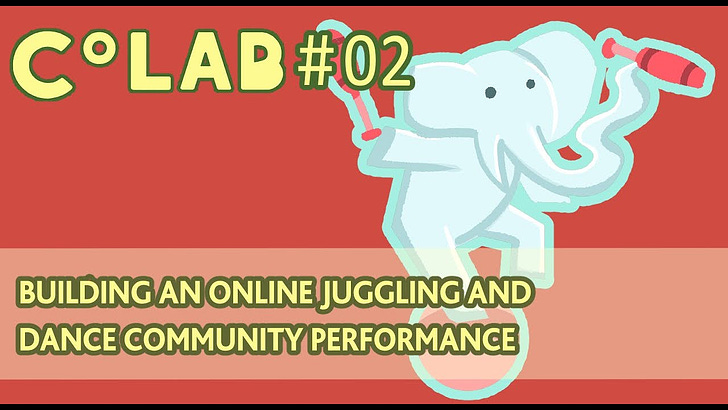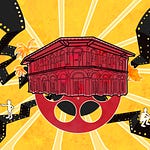Considering how ubiquitous Zoom has become, both as a communication and a collaboration tool, understanding and highlighting how individuals and groups have been using it to make artistic output and, most importantly, build human connection, is of the utmost importance. Rosas Re:Thrown presents a great example of best practice for online collaboration projects.
It started with two movement practitioners walking around Roath Lake. Zosia Jo is a self-described dance artist, and Lee Tinnion is a circus performer and juggler.
Two have been working together for nine years, yet this has been an organic face-to-face process that happens in studios and stages. A joint collaboration project had yet to happen. So, when the first pandemic lockdowns closed-up Wales, and the two artists decided to move in together, there was a natural progression towards really making something together
After a couple of walks, they realized they kept coming back to the theme of gravity. Lee with the motion of objects, Zosia with the motion of the body. But they didn’t get funding for that idea; the scope of the project they had come up with just didn’t work for the times. Maybe it will still happen, at a different when and in a different where.
“So, we looked at what is possible to do. Just to do it. To keep us creative, to keep us going.”
Walking around Roath Lake led to precious moments of co-ideation; one of them would present an idea, and the other would respond to it. What if we did this… what if we added that... Idle thoughts that would soon bloom.
Rosas danst Rosas is a legendary performance by Anne Theresa de Keersmaeker, itself a collaboration between de Keersmaeker and Thierry De Mey. Since 1983, the performance has been inspiring the world and waoing audiences since 1983 and later became the foundational work of the dance company Rosas. In 2013, de Keersmaeker opened up the process of Rosas danst Rosas to the public domain and encouraged others to work through, respond, and play with the framework.
A colleague of Zosia’s did a project with students over Zoom using the Rosas danst Rosas choreography. After watching it, Lee got curious about the choreography itself. “What would happen if you put juggling into this?” he asked.
Soon, a consensus for a project started to emerge.
Zosia and Lee proceeded to remix the language of the Rosas choreography through the language of juggling. “The fun part was to figure out how the ball would fit. And how to make a lot of balls fit.” Bringing something new while keeping the essence and movement was one of the many exciting parts of the process.
They came up with a lockdown friendly project – Rosas danst Rosas is itself a seated dance performance; no need for a big space to work in! – that definitely should have more than just the two of them on camera. So, they invited people from their existing communities to participate in the project. Their tool of choice: Zoom.
As we continue to chat, Zosia and Lee point out that they made sure that the remixed choreography they created had a common language that could be performed by anyone, regardless of skill level. “The baseline choreography would be achievable, but you will also be left lots of avenues,” by which Zosia means that people could run away with the base choreography, mate it their own; jugglers could add balls and make it more complex; dancers could explore different movements.
The remixed choreography was shared through three Zoom workshop sessions, one for movers, one for jugglers, and a session for older people. “And that session was predominantly our mothers,” Zosia adds with a smile. All participants had the option to watch video tutorial versions of the remixed choreography if they couldn’t attend. Whichever option participants chose, Zosia and Lee invited them to film their performance of the remixed dance-juggling and submit the videos, which Lee later edited together into a cohesive whole.
“A Zoom room is a space that is created by intention.” Zosia says. “There’s ways of being in it. You can, you do not feel the same level of connection. If you think about it, the space is created by the desire to be together. It is not a space in and of itself until we’re all here. And then it is thought about as a space. And then everyone is together.”
During our conversation, the pair shared some techniques they employed during the project. Talking to them it is obvious to me that their previous experience as dance and circus educators really helped them streamline the Zoom workshop process and see new approaches the technology allowed them.
Lee said something that struck me as a stroke of genius, and I haven’t experienced in any Zoom workshop or vocalized by anyone else. He would leave the Zoom room open after a workshop, and participants could use it however they wanted. Some would even start making plans for things to do outside of the workshops. Allowing Zoom to replicate those moments in time, in between, before, during, and after an activity do help transform the tool from a conference call into a space with specific intent. I wish more Zoom meetings would do this.
“If you see it for what it is, and what it really has to offer, then it becomes a tool in and of itself that you could celebrate.” Zosia said.
The way it is used, defines the outcome.
“There’s elements of teaching and delivering with a community within Zoom that aren’t a compromise at all.” Lee says. “I really made use of the ability of using the camera to show very detailed.” Like having closeups of the hands, at the same time that people could see him talking.
One of the biggest positives of Zoom that folks expound is how it has helped to shrink distances, and how it can make experiences available to more people. Zosia and Lee mention that this project would not have been a free, open-for-everyone programme if they had had to run it in a physical space. Not only having to deal with the disappointment of hiring a space and no one showing up, but rental costs alone would have created barriers. The digital aspect helped make the project more accessible.
“We had several different communities. We ran sessions with different focus.” But that wasn’t a barrier – dancers came to juggler sessions, and viceversa. Seeing the leaking between those communities. Everyone was connected. Some would have never met because they wouldn’t have gone to the sessions. And that was because we helped bring them together onto a same space, working on a singular project.” Lee says
Teaching through the platform came with a learning curve, of course. “I had to learn to be really articulate first, and then allow a lot of freedom. A compromise or shift in the structure of how I teach.” Zosia said.
And anyone who’s had to deliver a presentation to a conference call and manage a chat understands that, really, you need more than two sets of eyes to do that.
When I asked the pair if they think that the project created a lasting community, they looked at each other and agreed that the same rules as real life apply to Zoom. It takes long-term investment to build a sustainable, connected group. The people who most easily kept connections going after the project had already come from existing groups, like Lee’s online juggling course as part of NoKitState. “The regularity, the consistency, of building a group and a community is a very different thing to coming together to make something. And that is a challenge and a dichotomy I work with a lot, because I work with communities.” Zosia adds. Besides, there’s many ways to measure or even understand the legacy of a project. Zosia mentions that while some participants didn’t create any connections outside of the project, others took what they learned from the project and brought it into other projects.
We of course talked into other subjects and ideas regarding creative work, community, education and making art in this new decade.
I asked Zosia and Lee about the nature of Rosas Re:Thrown as a piece of digital content. I originally encountered it as a YouTube video, divorced from its community project core, thus, to me, the encounter with the media is fundamentally different.
Chasing the content monster, as Zosia called it, would have led to a completely different project. They could have made short clips out of the final film to help promote the premiere event, have more people come and see the show. But that would have fundamentally changed the essence of the project. While making a viral project may bring one form of value, perhaps that would be at the expense of the intimate community-building that took place. This is something we must consider, as forces beyond our control increasingly push us towards a commercial, or commercially-inspired model for funding arts and creative enterprises. One has to be careful chasing the content monster. It has claws.
From what Zosia shares of her experience of working in the arts sector of Wales, I have the feeling that there is an informal division in the way people work or are made to work. Some projects are very goal-oriented, all about the outcome, the butts on the seats. Others are about building communities, or about working with communities, but the very limitations in time and resources some funding pots place make it difficult to work in a truly transformative way in the first place.
“Engaging people in something new and creative and scary is a long-term process. Otherwise, you’re just skimming off the people who are most keen, who are doing these things all the time, who more easily hear about this.”
When I ask Zosia and Lee what would be an ideal way to work in the arts, they say that such an ecology has several different people doing several forms of work. Some are doing that long-term engagement where there is that baseline practice that is always happening, always building upon itself. Then there’s practitioners who are more project focused with short, sharp, powerful creations. And then there’s the partnerships who can move around and work in conjunction and go beyond.
Of course, there is much more in this conversation that would be a crime if I try to write it all down. If you can, do listen to the whole thing. All at once, or in little bits. There’s a wealth of knowledge these two movement practitioners share.
While I personally think that there is not one right approach to making art, both in the community, individually, digitally or physically, we all have a lot to learn from each other. Regardless of how folks in the future encounter Rosas Re:Thrown, as a piece of content or re-contextualized, the project created a space for dialogue and collaboration.
For the premiere of the film, participants brought their families to the Zoom room. There were silly games, there were drinks. It was like a real Christmas party where, for a moment, everyone shared in on something.





Building and Online Juggling and Dance Community Performance: CoLab 002